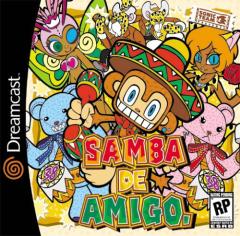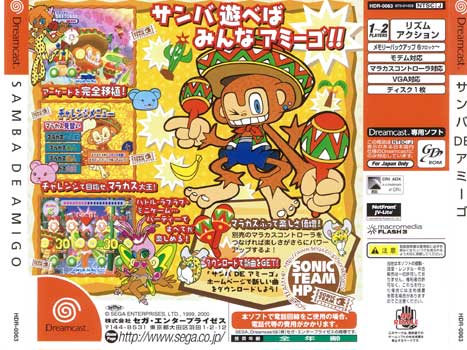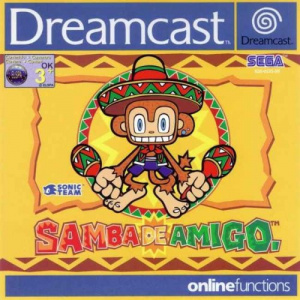

All you need to do is shake maracas accordingly, making the game incredible accessible right from the get-go.

This came out years before Guitar Hero ramped things up in terms of complexity and depth, but that’s not a problem.

By shaking two maraca-shaped motion controllers in six specific positions, you earn points. What is Samba de Amigo, you might be asking? Well, the original game came out in the late 90s on arcades and the Dreamcast, following in the footsteps of other rhythm games of the time, such as Dance Dance Revolution and Taiko no Tatsujin. Not to mention it runs very well in handheld mode, making it a perfect timewaster for bus or train journeys.The joyful kind of fun only the Dreamcast was able to provide is back. Party Central doesn’t make any major rhythm action faux pas and is an overall solid experience, that can be enjoyed by both casual players and diehard enthusiasts. These are fun, though, if there’s a bunch of you taking turns and making use of the motion controls to ensure everyone looks as silly as possible. Two of them are fundamentally the same since they involve getting a better score or more followers than your opponent, while the third is more of a co-op mode that requires you be in sync with your partner.
#SAMBA DE AMIGO DREAMCAST OFFLINE#
There’s a handful of different multiplayer options, including an online battle royale style mode, but most of the offline modes ultimately aren’t that different from each other. Again, there’s no story here but the presentation’s nice. There’s a cute mission mode, too, where you complete challenges, like beating a song with at least an A rank, that’s presented as if you’re a live streamer accruing followers.
#SAMBA DE AMIGO DREAMCAST PLUS#
Samba De Amigo: Party Central – there’s some nice Sega fan service but most of it is relegated to DLC (Picture: Sega)Īside from playing through all the songs, there is an in-game achievements list for completionists, plus a pseudo battle pass where clearing songs earns you points that unlock extra cosmetics or money to buy more cosmetics, letting you dress up Samba however you like (yes, this includes his classic sombrero). It’s much more reliable, although using the sticks to replicate the mid-song poses isn’t as fun, even if it avoids tiring your arms out (no joke, our arms were sore the day after our play session). Sega even seems to have accounted for this since you can miss a few beats and still walk away with an S rank.Īlthough if you care about getting perfect scores, you’ll want to swap to the second control scheme, where you use the buttons and control sticks. Party Central is, paradoxically, both very strict and very lenient when it comes to the controls, so it kind of balances out and makes playing with the motion controls mostly fine and not irritating. However, at the same time, there were several instances of the opposite happening the game would recognise beats that we felt we didn’t deserve. Plenty of missed beats felt like the result of the game thinking we weren’t holding the Joy-Cons in the right position when we most definitely were. When we previewed Party Central back in May, we noticed that its motion controls weren’t entirely accurate and unfortunately that remains the case. The Nintendo Switch’s Joy-Cons are the perfect continuation of that, although they don’t work quite as perfectly as you’d hope. Party Central gets a pass on the song list front but what about the controls? The original Samba De Amigo made use of motion controls long before the Nintendo Wii made them popular, coming with a pair of maraca controllers to shake.

Whatever the reason, it’s a solid line-up, although unfortunately there are no hidden unlockable songs to work towards. Perhaps Sega figured Samba De Amigo would prove too obscure for the Zoomer generation (it has been 13 years since the last game) and the primary audience would be people who grew up playing the Dreamcast original. Most of the songs come from the 2010s, with several 20th century Latin flavoured tracks, like Macarena and La Bamba, to show that Samba hasn’t entirely discarded his roots, even if he’s ditched the sombrero.
#SAMBA DE AMIGO DREAMCAST FULL#
It’s by no means a bad one, and full of recognisable bops, perfect for the game’s party vibe, although it definitely seems more catered towards Generation X and Millennials. We’re genuinely curious how Sega decided which music tracks to licence for this game because, at a cursory glance, it just seems like an incredibly random selection. As soon as you’ve completed the tutorial you have carte blanche to play through any of Party Central’s eclectic list of 40-odd songs, at one of four difficulties. Beyond an introductory scene of you lifting a pair of maraca like Excalibur, accompanied by narration of you bringing ‘beat back to the world’, there is no plot to speak of.


 0 kommentar(er)
0 kommentar(er)
